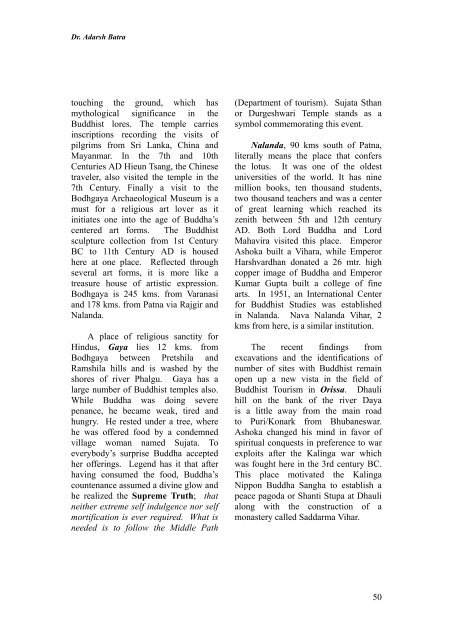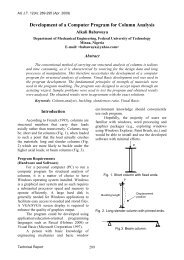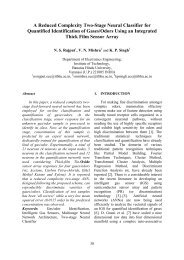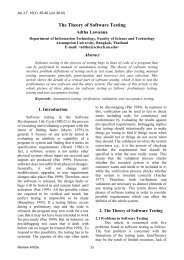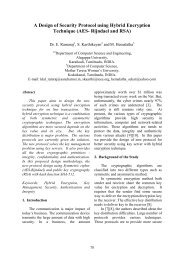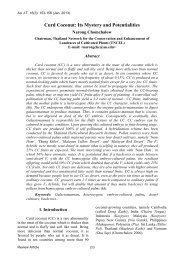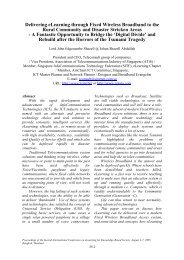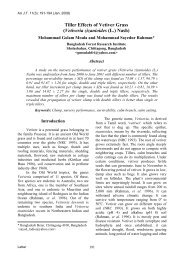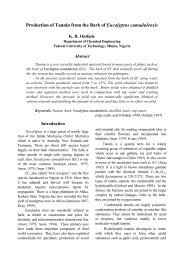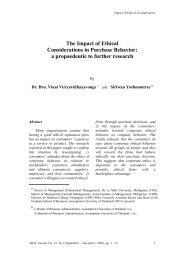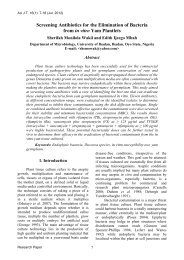Indian Tourist sites â In the footsteps of the Buddha - AU Journal ...
Indian Tourist sites â In the footsteps of the Buddha - AU Journal ...
Indian Tourist sites â In the footsteps of the Buddha - AU Journal ...
You also want an ePaper? Increase the reach of your titles
YUMPU automatically turns print PDFs into web optimized ePapers that Google loves.
Dr. Adarsh Batra<br />
touching <strong>the</strong> ground, which has<br />
mythological significance in <strong>the</strong><br />
Buddhist lores. The temple carries<br />
inscriptions recording <strong>the</strong> visits <strong>of</strong><br />
pilgrims from Sri Lanka, China and<br />
Mayanmar. <strong>In</strong> <strong>the</strong> 7th and 10th<br />
Centuries AD Hieun Tsang, <strong>the</strong> Chinese<br />
traveler, also visited <strong>the</strong> temple in <strong>the</strong><br />
7th Century. Finally a visit to <strong>the</strong><br />
Bodhgaya Archaeological Museum is a<br />
must for a religious art lover as it<br />
initiates one into <strong>the</strong> age <strong>of</strong> <strong>Buddha</strong>’s<br />
centered art forms. The Buddhist<br />
sculpture collection from 1st Century<br />
BC to 11th Century AD is housed<br />
here at one place. Reflected through<br />
several art forms, it is more like a<br />
treasure house <strong>of</strong> artistic expression.<br />
Bodhgaya is 245 kms. from Varanasi<br />
and 178 kms. from Patna via Rajgir and<br />
Nalanda.<br />
A place <strong>of</strong> religious sanctity for<br />
Hindus, Gaya lies 12 kms. from<br />
Bodhgaya between Pretshila and<br />
Ramshila hills and is washed by <strong>the</strong><br />
shores <strong>of</strong> river Phalgu. Gaya has a<br />
large number <strong>of</strong> Buddhist temples also.<br />
While <strong>Buddha</strong> was doing severe<br />
penance, he became weak, tired and<br />
hungry. He rested under a tree, where<br />
he was <strong>of</strong>fered food by a condemned<br />
village woman named Sujata. To<br />
everybody’s surprise <strong>Buddha</strong> accepted<br />
her <strong>of</strong>ferings. Legend has it that after<br />
having consumed <strong>the</strong> food, <strong>Buddha</strong>’s<br />
countenance assumed a divine glow and<br />
he realized <strong>the</strong> Supreme Truth; that<br />
nei<strong>the</strong>r extreme self indulgence nor self<br />
mortification is ever required. What is<br />
needed is to follow <strong>the</strong> Middle Path<br />
(Department <strong>of</strong> tourism). Sujata Sthan<br />
or Durgeshwari Temple stands as a<br />
symbol commemorating this event.<br />
Nalanda, 90 kms south <strong>of</strong> Patna,<br />
literally means <strong>the</strong> place that confers<br />
<strong>the</strong> lotus. It was one <strong>of</strong> <strong>the</strong> oldest<br />
universities <strong>of</strong> <strong>the</strong> world. It has nine<br />
million books, ten thousand students,<br />
two thousand teachers and was a center<br />
<strong>of</strong> great learning which reached its<br />
zenith between 5th and 12th century<br />
AD. Both Lord <strong>Buddha</strong> and Lord<br />
Mahavira visited this place. Emperor<br />
Ashoka built a Vihara, while Emperor<br />
Harshvardhan donated a 26 mtr. high<br />
copper image <strong>of</strong> <strong>Buddha</strong> and Emperor<br />
Kumar Gupta built a college <strong>of</strong> fine<br />
arts. <strong>In</strong> 1951, an <strong>In</strong>ternational Center<br />
for Buddhist Studies was established<br />
in Nalanda. Nava Nalanda Vihar, 2<br />
kms from here, is a similar institution.<br />
The recent findings from<br />
excavations and <strong>the</strong> identifications <strong>of</strong><br />
number <strong>of</strong> <strong>sites</strong> with Buddhist remain<br />
open up a new vista in <strong>the</strong> field <strong>of</strong><br />
Buddhist Tourism in Orissa. Dhauli<br />
hill on <strong>the</strong> bank <strong>of</strong> <strong>the</strong> river Daya<br />
is a little away from <strong>the</strong> main road<br />
to Puri/Konark from Bhubaneswar.<br />
Ashoka changed his mind in favor <strong>of</strong><br />
spiritual conquests in preference to war<br />
exploits after <strong>the</strong> Kalinga war which<br />
was fought here in <strong>the</strong> 3rd century BC.<br />
This place motivated <strong>the</strong> Kalinga<br />
Nippon <strong>Buddha</strong> Sangha to establish a<br />
peace pagoda or Shanti Stupa at Dhauli<br />
along with <strong>the</strong> construction <strong>of</strong> a<br />
monastery called Saddarma Vihar.<br />
50


